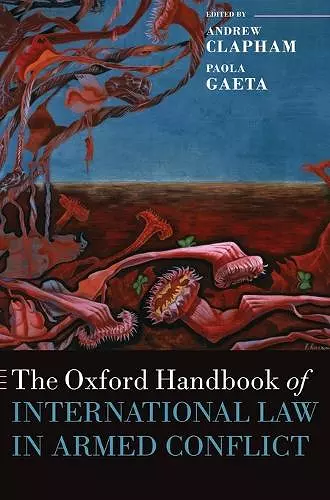The Oxford Handbook of International Law in Armed Conflict
Andrew Clapham editor Paola Gaeta editor
Format:Hardback
Publisher:Oxford University Press
Published:13th Mar '14
Currently unavailable, and unfortunately no date known when it will be back
This hardback is available in another edition too:
- Paperback£49.49was £49.49(9780198748304)

Which human rights violations or war crimes allegations result in exclusion from the refugee regime? What human rights protections apply to someone declared an unlawful combatant? Which human rights obligations apply to the actions of armed forces acting abroad? Over the past ten years the content and application of international law in armed conflict has changed dramatically. An authoritative and comprehensive study of the role of international law in armed conflicts, this Oxford Handbook engages in a broad analysis of international humanitarian law, human rights law, refugee law, international criminal law, environmental law, and the law on the use of force. With an international group of expert contributors, this book has a global, multi-disciplinary perspective on the place of law in war. The Handbook consists of 35 Chapters in seven parts. Part A provides the historical background and sets out some of the contemporary challenges. Part B considers the relevant sources of international law. Part C describes the different legal regimes: land warfare, air war fare, maritime warfare, the law of occupation, the law applicable to peace operations, and the law of neutrality. Part D introduces crucial concepts in international humanitarian law: weapons and the concepts of superfluous injury and unnecessary suffering, the principle of distinction, proportionality, genocide and crimes against humanity, grave breaches and war crimes, and internal armed conflict. Part E looks at fundamental rights: the right to life, the prohibition on torture, the right to fair trial, economic, social and cultural rights, the protection of the environment, the protection of cultural property, the human rights of the members of the armed forces, and the protection of children. Part F covers important issues such as: the use of force, terrorism, unlawful combatants, the application of human rights in times of armed conflict, refugee law, and the issues of gender in times of armed conflict. Part G deals with accountability issues including those related to private security companies and armed groups, as well as questions of state responsibility brought before national courts and issues related to transitional justice.
Clapham and Gaeta are to be congratulated for their Herculean efforts in assembling a book that fairly represents the vast disagreement and contestation that currently inhabits the legal regulation of warfare. The Handbook paints a complex picture of overlapping legal domains all pushing and competing to regulate military conduct. Whether or not this competitive process is coherent depends on which author in the Handbook is asked, a pluralism that accurately reflects the state of the field today. * AJIL, Jens David Ohlin, Cornell Law School *
The Handbook doubtless represents a basic work on international law application in armed conflicts and it is certainly appropriate to determine to a broad extent the further discussion of many of the subjects so diligently examines. * Knut Ipsen, German Yearbook of International Law *
The book is also quite a fresh approach in an increasingly crowded market. The high rate of new publications on international humanitarian law and its associated topics continues, so it is important that entrants have something different to offer. The distinguishing features of this book are its multi-dimensional approach, the calibre of its contributors, and their willingness to offer no-holds-barred opinions on controversial topics. These features comfortably imbue the book with the requisite value-add... If this book were read cover to cover, the reader would be left with a comprehensive survey of the most important legal issues in the context of modern armed conflicts. It is therefore recommended to those who are seeking this advanced understanding from a multidimensional, critical perspective. * Damien van der Toorn, Australian Year Book of International Law *
...this handbook is a useful, up-to-date and comprehensive tool for scholars and practitioners, especially judges, dealing with the legal issues arising out of armed conflicts. * William St-Michel, International Journal of Criminal Justice *
The stated purpose of the Handbook is 'to provide grounding for those who would like to go further with their understanding of the law applicable in armed conflict.' The Handbook fulfils this purpose amply. Not only does it provides a comprehensive introduction to the law applicable in armed conflict, it also offers ample food for thought on the structure of the international legal system and the character of international legal obligations. * Naomi Burke, The British Yearbook of International Law *
One remarkable feature of The Handbook is its exhaustiveness: it provides a comprehensive overview of the multiple rules and rights that come into play during an armed conflict. Furthermore, it clearly stems from the sum of the essays that the legal framework applicable to an armed conflict is not single-fold, but multifaceted. This handbook is a useful, up-to-date and comprehensive tool for scholars and practitioners, especially judges, dealing with the legal issues arising out of armed conflicts. * William St-Michel, Journal of International Criminal Justice *
ISBN: 9780199559695
Dimensions: 249mm x 181mm x 57mm
Weight: 1640g
1008 pages